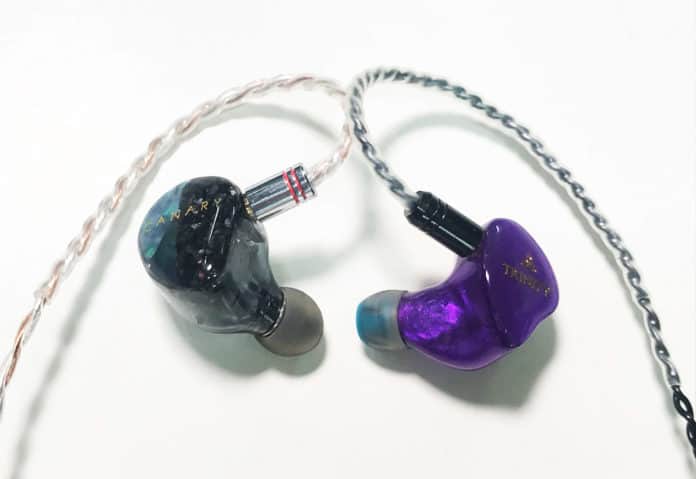In what was one of the most interesting and complex comparisons reviews I’ve ever conducted, this week I went over the similarities and differences between two innovative IEMs: the AAW Canary and the Jomo Trinity. Both IEMs use three different transduction types (including dynamic, balanced armature, and electrostatic drivers). Their beautiful looks could be mistaken for jewelry. And they both have an incredible sense of detail and specificity to their sounds. But which one is right for you? Let’s take a closer look with this AAW Canary vs Jomo Trinity Comparison Review!
AAW Canary vs Jomo Trinity Comparison Review
In the Box
| AAW Canary | Jomo Trinity |
| AAW Canary IEMs | Jomo Trinity IEMs |
| Null Audio Symphonym Hakone UPOCC Silver/Copper Cable (2-pin, 3.5 mm connector) | detachable 2-pin cable with 3.5 mm connector |
| magnetic storage case | silicone eartips |
| wooden carrying case | two-flange eartips |
| micro fiber cloth | 3.5 mm to 6.35 mm adapter |
| airplane adapter | airplane adapter |
| 3.5 mm to 6.35 mm adapter | cleaning tool |
| silicone eartips (s, m, l) | clip |
| bass silicone eartips (s, m, l) | cylinder carrying case |
| foam eartips (s, m, l) | big, zipping carrying case |
| 2-flange tips | documentation card |
| warranty card |
Design
Look and Feel
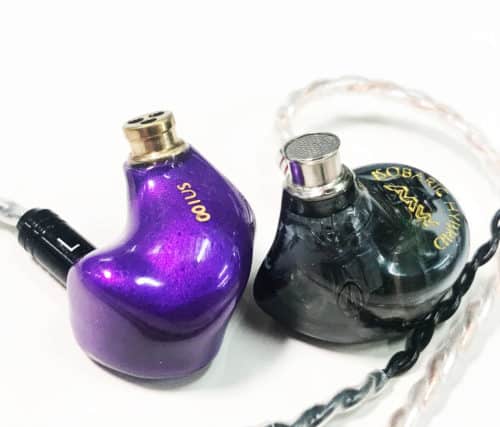
Both the AAW Canary and the Jomo Trinity are strikingly gorgeous IEMs. They both look and feel expensive, as they should for their price points (the Canary runs for $1999 and the Trinity goes for $2799).
On one hand, the face-plate of the AAW Canary has a pretty, opal looking shine to it with beautiful glittery details. The backside of its driver housing is opaque, and thus you can see through into the inner workings of the IEM. On the other hand, the Jomo Trinity’s shell is a bright, shiny purple colors. In the light it sparkles and the gradients of its color reveal themselves. A funny coincidence: both IEMs mark the name of the model on the face-plate in gold lettering.
While both IEMs sizes are similar to each other, their shapes are different. They both have extended nozzles. However the Jomo Trinity’s shape seems more specific to fit in the ear, whereas the AAW Canary has more of a universal shape.
Lastly, the two IEMs have metal nozzles. However, their designs are different from one another.
On one hand, the AAW Canary has what looks like a steel nozzle with numerous small perforations. On the other hand, the Jomo Trinity has brass nozzles with 3 large perforations. These design differences culminate in the way the eartips fit and look on the IEMs. The eartips of the Canary have smaller ports directing the sound. By contrast, the Jomo Trinity has a larger hole, revealing the brass nozzle.
Comfort and Fit
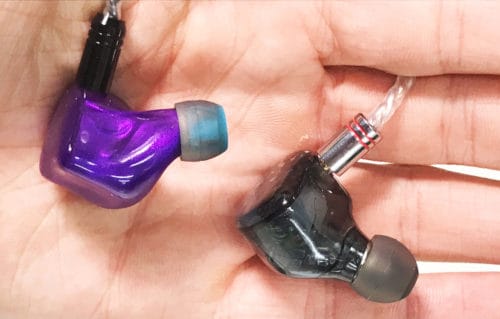
Since both the AAW Canary and the Jomo Trinity have large driver housings, neither were the perfect fit for my smallish ears. That said, because of the ear-like shape of the Trinity, it fit a bit quicker and easier than the Canary. That said, because both IEMs had long nozzles, both, once in place, were actually pretty comfortable. Neither touched my ear in any hard, distracting way. Additionally, both earphones’ earhooks helped to keep them sitting in place in my ear. The Canary seemed to rely more on the fit of the eartip inside the ear canal, while the weight was more evenly distributed with the Trinity. As a result, overall, the Trinity felt more comfortable.
Cable
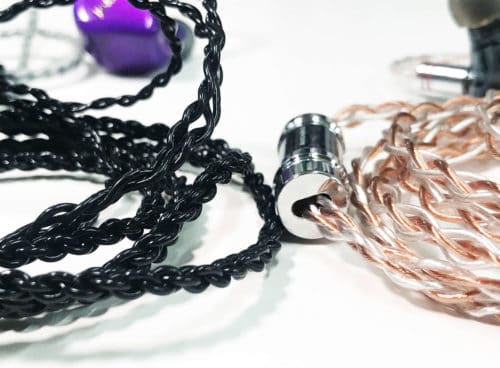
Both the AAW Canary and the Jomo Trinity have detachable, 2-pin cables which terminate to 3.5 mm connectors. Both have a braided, litz design and have two individually insulated conductors per side. Additionally, they both have molded ear hooks which help keep the IEMS in place.
AAW outsourced their cable design to Null Audio. As a result, the AAW Canary comes with a Null Audio Symphonym Hakone UPOCC Silver/Copper cable. Its connectors have weight and feel extremely well made. Its clear jacket reveals the copper and silver inside and as a result it has a super high end look and feel.
On the other hand, the cable of the Jomo Trinity is made of silver plated copper. Its connectors are a bit less bulky, but still feel strong. Its braid is wrapped tighter than the Null Audio cable. Additionally, its conductors have black jackets rather than clear.
Drivers
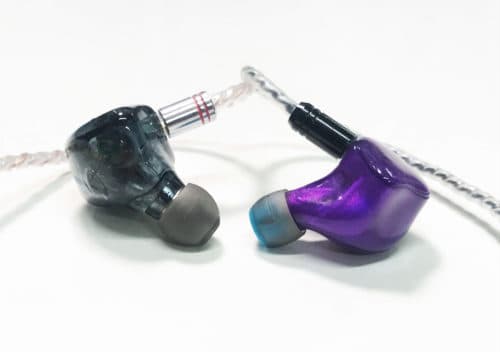
Both the AAW Canary and the Jomo Trinity have revolutionary driver designs, which is why I’m doing this comparison review despite their different price points. Both have three different types of transducers: dynamic, balanced armatures, and electrostatic drivers. The correlation between the drivers and crossover points of the lows, mids, highs, and ultra highs is remarkably similar. One big difference between the IEMs, however, is their dynamic drivers.
In the AAW Canary, the dynamic driver is a dual 6mm isobaric driver. It has a push pull design and AAW has this to say about it:
“The 6mm dual isobaric(push-pull) woofer is equipped with dual diaphragms and high strength neodymium magnets. The isobaric design offers inverse phasing between the voice coils to eliminate non-linearities in typical dynamic woofer. By further utilizing TruXross+ technology, it is to only function in minimal overlapping frequency range as opposed to the balanced armature drivers. It pushes the bass performance to a new level in the Canary while not overpowering the rest of the spectrum.”
On the other hand, the Jomo Trinity has a single 8mm dynamic driver.
Both the AAW Canary and the Jomo Trinity have dual electrostatic super tweeters dedicated to the ultra high frequencies. Additionally, both have four balanced armature drivers dedicated to the mid and high frequencies.
Sound
Low Frequencies
The low frequencies of both the AAW Canary and the Jomo Trinity are quick and punchy! They both have a sense of clean, clear low end. They both have a little bit of a low frequency emphasis, but those highlights are in slightly different areas of the frequency spectrum. On one hand, the Canary’s emphasis feels deeper, around perhaps 40 Hz, like it has a clear, yet solid sense of subbiness. It provides dimensionality and impact for genres that utilize ultra low lows for emotional expression.
By contrast, the Jomo Trinity has light emphasis a little bit higher in the lows, around what sounded like 60Hz. As a result, its punchiness has a feeling of chest to it. And while it had a nice sense of extension as well, it felt a bit less deep than the Canary.
I was extremely impressed by both the AAW Canary’s and the Jomo Trinity’s ability to recreate tight, accurate low frequency pitch. And while they had slightly different shapes, they were remarkably similar in the way they handled transient response and pitch.
For example, when I was listening to the song Diamond Heart by Lady Gaga, the kick drum in the chorus drop had a pitch perfect tonality with both the AAW Canary and Jomo Trinity. It contributed amazingly to the emotional impact of that section of the song with both IEMs. The biggest difference there was that the the subs felt more clear in the Canary, whereas the lows of the kick had better separation from the low-mid-rich bass, guitars and keys with the Trinity.
Middle Frequencies
The midrange of the AAW Canary and the Jomo Trinity, like the low frequencies, feels similarly quick in transient response and emotional impact, but has a different frequency response shape. On one hand, the Canary seems to have a thicker low mid response whereas the Trinity seems to have a little cut that sounds like its around 400 Hz. Additionally, the high-mids of the Canary and Trinity have differently shaped boosts and cuts which give them a similar amount of presence, but which sounds different from one another. As a result, the shape of vocals feels different between the two, although both IEMs have a wonderful feeling of presence and intimacy.
For example, when I was listening to the song Izzy Izzy Ahh by Missy Elliott, the bass guitar felt a bit fuller with the AAW Canary. It had a feeling of dimensionality. By contrast, the bass guitar feels a bit more intimate and tight with the Jomo Trinity, but didn’t feel quite as deep and musical.
Additionally, when I was listening to the song No Dad by Taylor Hollingsworth, the dirty, crunchy electric guitar had a sense of emphasis in a different place with the Canary than the Trinity. The Canary’s emphasis in the high-mids made that guitar come through with a greater sense of presence and texture than the Trinity. The Trinity’s high-mid emphasis made it’s presence feel a bit smoother and pushed the texture more so into the high frequencies than the high-mids.
Additionally, the high-mids of the Jomo Trinity seemed to leave more space for the vocal. By contrast, the body of the vocal seemed to sit back into the guitar with the Canary. The top part of the high-mids brought the face and throat of the vocal forward in the mix to differentiate it, and overall this actually felt more natural for that song to my ears. Overall, the midrange of the Canary feels chunkier than the Trinity. Meanwhile, the Trinity’s midrange feels more V-shaped.
High Frequencies
The high frequencies of both the AAW Canary and the Jomo Trinity have lots of detail, extension, and a pretty sense of shine. Both have a little bit of character while maintaining a sense of fullness and harmonic complexity. They have a sense of emphasis in the upper octave, providing airiness and lift. As a result, both greatly enhance the sense of emotional impact of mixes that utilize the highs for emotional expression. Separately from the upper octave response, however, the two differ in the way they handle the other areas of the high frequency response.
On one hand, the AAW Canary has a sense of emphasis toward the lower treble. This provides articulation for vocals and drums and attacks in general. A bit of a cut in the upper treble helps the Canary avoid harshness, so the highs have specificity without a hard bite.
By contrast, in addition to its emphasis in the upper octave, the Jomo Trinity has emphasis in the upper treble. This boost gives specificity to textures and a sense of lightness and delicacy to the highs as a whole.
As a result, generally, the Trinity’s highs feel lighter and more delicate, whereas (like the midrange), the Canary has more chunkiness, thickness and harmonic richness.
For example, when I was listening to the song Miles Runs the Voodoo Down by Miles Davis, the cymbals seemed to have more fullness with the AAW Canary. They’re exact character seemed to come through in a more detailed way. By contrast, though, with the Jomo Trinity, the cymbals seemed to have an emphasized texture. They felt a bit lighter. Additionally, this upper treble emphasis provided separation from the midrange.
Soundstage
The soundstage of both the AAW Canary and the Jomo Trinity felt expressive and had a sense of nuance across all three dimensions. Because of the shape of their frequency response, the form of the soundstage felt different from one another.
In a general sense, the AAW Canary seemed to have a greater sense of extension in all three dimensions, but the Jomo Trinity had a more delineated sense of nuance within those dimensions, particularly in mid-range and high-frequency rich instruments.
For example, when I was listening to the song Slow Burn by Kacey Musgraves, the sense of width of the wide synths in the bridge felt more expansive with the Canary than the Trinity. That said, in that same section, there was a more clear differentiation between the synths, strings, and background vocals in space, which filled in the extremes.
Additionally, when the drums and bass come in during the 2nd verse, the sense of deepness of the kick drum and the highness of the high-hat pattern felt more extended with the Canary. However, because of the midrange dip of the Trinity, there was more spaciousness in the sense of height in the mids, which separated the high parts of the vocal from the lows and low-mids of the bass, synths, strings, and background vocals.
Lastly, in the 2nd chorus of the song, the mids in the banjo and moving synth reverb sounded fuller and more expressive with the Canary, but more separated from the rest of the mids with the Trinity. Both soundstages are complex. As a result, it is hard to articulate the nuances of difference between them. But in general, both IEMs related the soundstage in an emotionally impactful way. That said, the Canary seemed to have a little bit more expansion to its staging.
Overview
Overall, the AAW Canary and the Jomo Trinity are very special IEMs that have a wonderful sense of expressiveness and energy. Both work for a myriad of genres. The Canary has a bit of a deeper bass and thicker midrange, whereas the Trinity has more texture in the highs and spaciousness in the mids. Both had beautiful soundstages, but felt slightly different in part because of their relationship to their midrange shapes.
That said, my favorite genres for the Canary were jazz, indie rock, hip-hop, pop, and anything with super sparse arrangements (although it worked super well for thick arrangements too!). My favorite genres for the Trinity were pop, and vocal music like folk, as well as bluegrass and older, classic rock.
The AAW Canary and the Jomo Trinity are available for the best price here:
MajorHiFi may receive commission through retail offers.
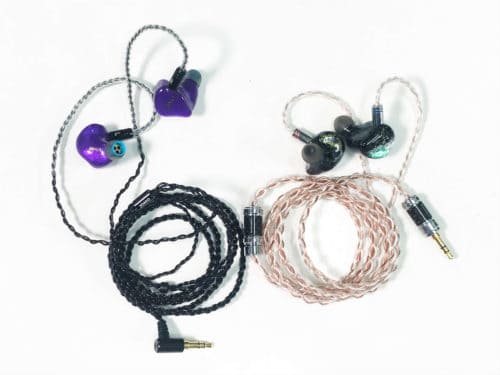
Compare the ranking of various headphones, earbuds and in-ear monitors using our tools.
Discuss this, and much more, over on our forum.
---MAJORHIFI may receive commissions from retail offers.


